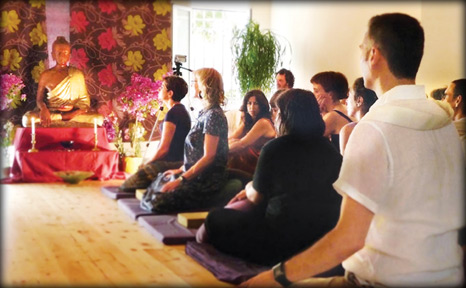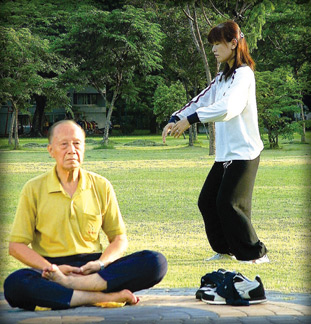The West turns to Buddhist meditation
By Kalakeerthi Dr. Edwin Ariyadasa
“When worldly
vicissitudes impact upon a person, he must remain, mind unshaken. That
is a noble quality.”
- The
Buddha
|

Mindfulness meditation gathers momentum |
In the modern world, dominated as it is by angst, the unshaken mind
is a rarity indeed. Stress affects all. Tempers are short. Violence
lurks everywhere. Hatred, jealousy and intolerance have escalated into
epidemic proportions.
Irresistibly persuasive modern media, through their sophisticated
messages, ensnare consumer-masses into a fairy world of unending
expectations. The inevitable corollary of this phenomenon is a
devastating sense of frustration, when the tantalising dreams escape the
human grasp.
Men and women, in our time, are always rushed. They hurry to a place
only to hurry back. Distractions rend every moment into shreds.
Deprived, even of a wee bit of repose, they cannot experience and savour
life. Reduced to helpless ‘sleep-walkers’ and automata, they have no
time to ‘stand and stare’. Man must awaken into the ineffable beauty of
life and its overwhelming joy.
The keen yearning to ‘wake up’ to life, has gnawed at the soul of men
and women for ages. Religious teachers have advocated systems to cope
with this troubling urge.
Technique
Among all those efforts, the transcendental technique evolved by the
Buddha, has proved perennially efficient and universally applicable.
This Buddha-system, known the world over as Satipatthana (Mindfulness
Meditation), has currently surged into a massive wave in the west
desperately seeking a way out of the anxiety-ridden life-routine they
are forced into.
The story of this movement, sweeping across the US and some other
regions, was quite impressively chronicled by the globally reputed
writer Kate Pickert.
Quite clearly inspired by the Buddhist technique of mindful
meditation, this modern system is titled Mindfulness Based Stress
Reduction (MBSR).
MBSR instructors
MBSR has attained the stature of a scientific ‘mind-Awakening course,
the surprising outcome of which is the awareness of the real pulsating
spasm of life that lies below the thick carapace of repetitive routines.
The course is so efficiently organised that “there are nearly 1,000
certified MBSR instructors, teaching mindfulness techniques and they are
in every state and in more than 30 countries.”
The mindfulness study system has been developed by Jon Kabat Zinn and
MIT Scientist. Its pragmatic effectiveness is vouched for by its
participants.
The broad approach of this course follows the original Satipatthana
system - in Satipatthana (Mindfulness Meditation), the practitioner is
instructor to be mindful of all the activities he goes through.
(The original Pali puts it somewhat like this: Gate, Thite, sutte,
jagorite, bhasite, tanhibhave sampajana hott. Be mindful when you walk,
when you stand, when you sleep, when you are awake, when you talk, when
you are silent).
The MBSL practitioners are given some exercises which follow the
contours of the original Buddha system. The “author recounts her
experience of eating a raisin, as instructed by the teacher. This is
what she has to say about the experience: “I’m eating a raisin. But for
the first time in my life, I’m doing it differently. I’m doing it
mindfully.
Benefits
This whole experience might seem silly, but we are in the midst of a
popular obsession with mindfulness as the secret in health and happiness
and a growing body of evidence suggests it has clear benefits.”
These evident benefits have enabled this new mindfulness technique to
penetrate into quite unexpected segments of society. The technique has
been accepted by Silicon Valley entrepreneurs and Pentagon chiefs.
The classes are quite methodically organised Meditation is imperative
meditation that focuses on one’s breath is a direct derivative of
Buddhist Ana-pana Sati Meditation. (Concentration of breathing in and
breathing out).
The organisers do not characterise the technique as Buddhist to keep
the experience entirely free, as a human matter-bereft of
categorisations.
 In this version, “attention” itself is thought of as a muscle. As any
other in the body, that muscle to with gain strength through exercise.
And meditation is the exercise for this specific muscle. In this version, “attention” itself is thought of as a muscle. As any
other in the body, that muscle to with gain strength through exercise.
And meditation is the exercise for this specific muscle.
Fascination
Mindfulness Meditation continues to fascinate people from all walks
of life. To these westerners, inhabiting high-powered social realm, the
need for mindfulness is becoming an increasingly essential way of
responding to their human destiny.
Influential groups, have taken to mindfulness meditation, with an
earnestness that is surprising. In some US companies, each building has
its own meditation room.
Prominent factor
Literature on mindfulness keeps on burgeoning. Congressmen campaign
for increased federal funds for mindfulness research.
What is taking place in the Western world in the field of mindfulness
meditation is quite likely to prove a global trend in the years to come.
In some educational institutes in the US Mindfulness Teaching has
become a prominent factor in the curriculum. It is reported that in some
areas, via program called mindful schools, online mindfulness training
is offered to teachers. A strange development seems to be in the offing.
Oriental cultures which received the Buddha’s mindfulness technique as
part of their ancient spiritual traditions are now turning to the MBSR
guru from the US to inculcate in them the techniques of mindfulness
meditations.
We in Sri Lanka could turn to our Satipatthana mindfulness
meditation, heritage and instruct our people in this mind-training
technique, acquiring whatever benefits we can from the Western
innovations.
The younger generation in our country, is specifically important.
They are exposed to various influences that breed anxieties in them,
even when they are very young.
We could train them in mindfulness meditation. Utilising our own
age-old tradition of satipatthana. |

